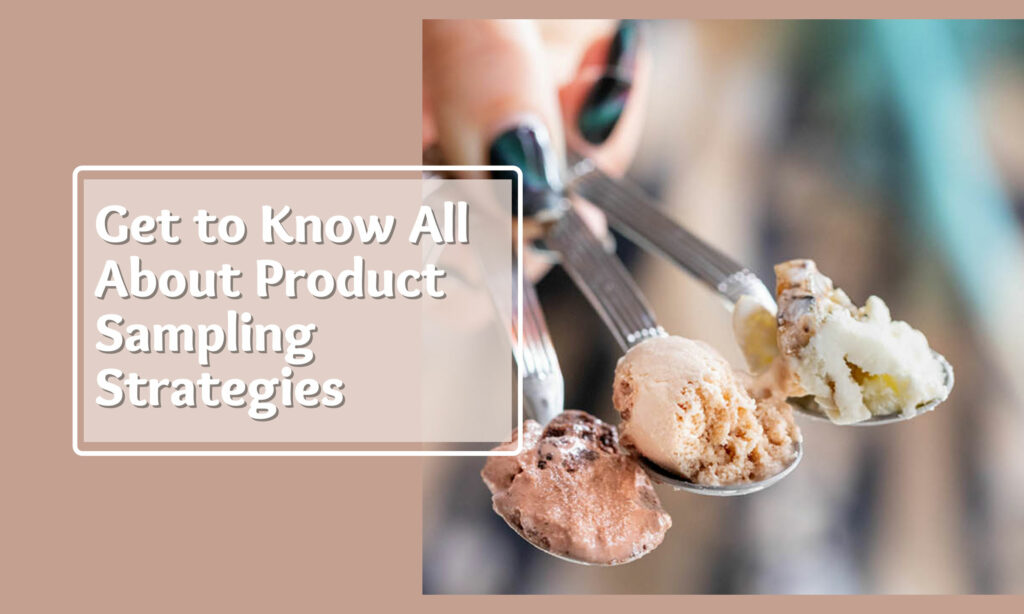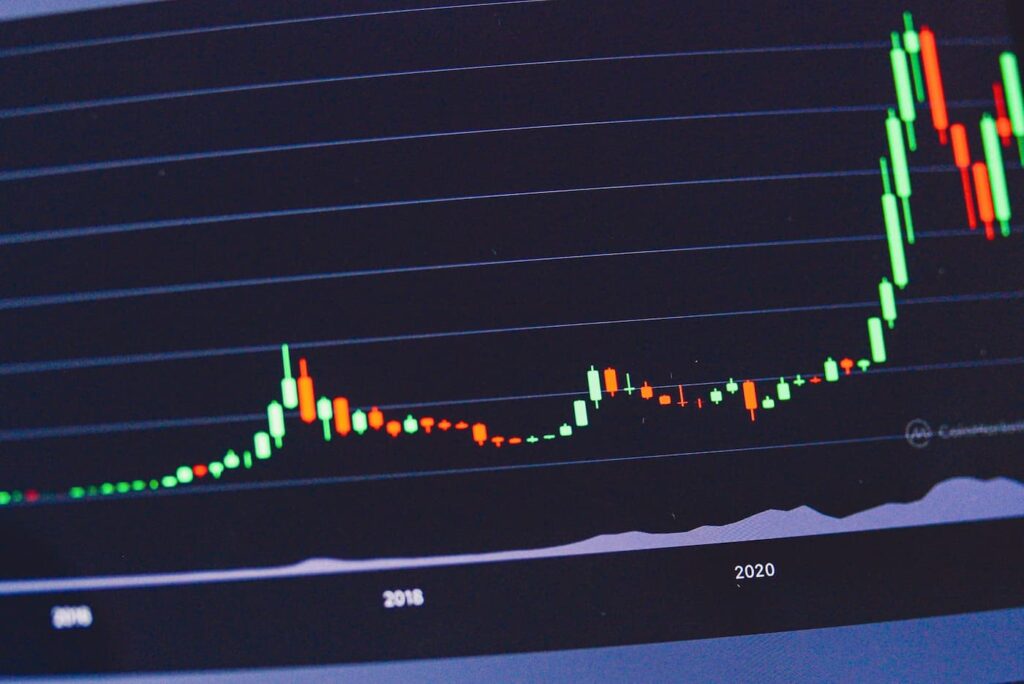Product sampling strategies have long been essential for brands looking to place their products directly in consumers' hands. This approach, known as product sampling marketing, offers a valuable opportunity: consumers enjoy trying products for free, while brands benefit from increased visibility and customer engagement.
However, a successful product sampling strategy requires careful planning to achieve meaningful results. From selecting the right sampling products to targeting specific audiences, brands must go beyond simple giveaways to make a lasting impact in a crowded market.
For small businesses, finding budget-friendly ways to offer product samples can help them gain a competitive edge. Meanwhile, marketing teams focused on sustainability may need eco-conscious sampling options that align with their brand's values.
Understanding how to do product sampling effectively means tapping into these strategic insights, ensuring each sample not only reaches the right audience but also contributes to long-term brand growth.
Peekage solutions: Product sampling services
What is Product Sampling?
Product Sampling is when companies spread the word about their product by letting consumers try it before buying it. With product sampling, you give free samples of your new products to your targeted audience to gain traffic and awareness.
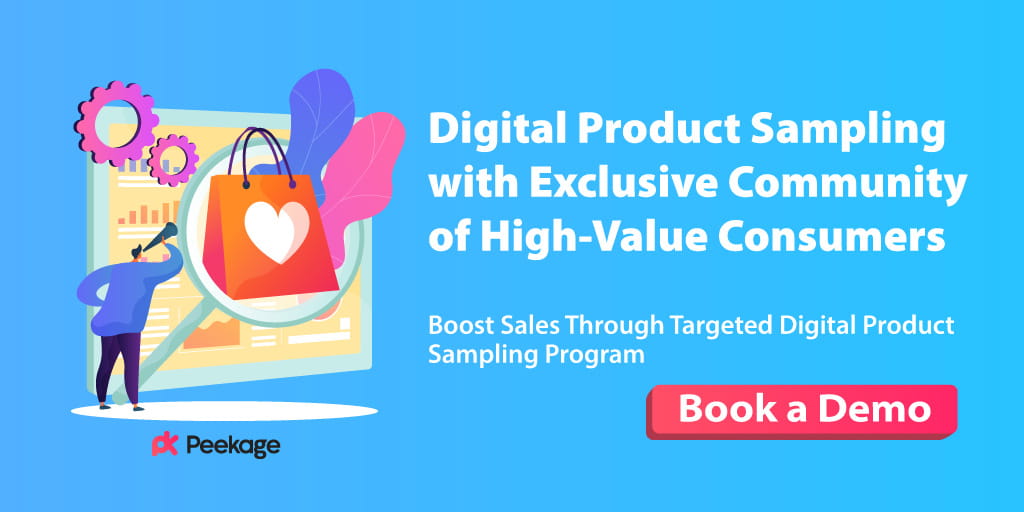
Types of product sampling
There are two types of product sampling methods:
An indirect product sampling strategy is a method with no physical interaction between you and clients. i.e. offering free samples of a product to consumers when they buy another product.
Sephora often includes free samples with online purchases, allowing customers to try additional products without visiting a physical store.
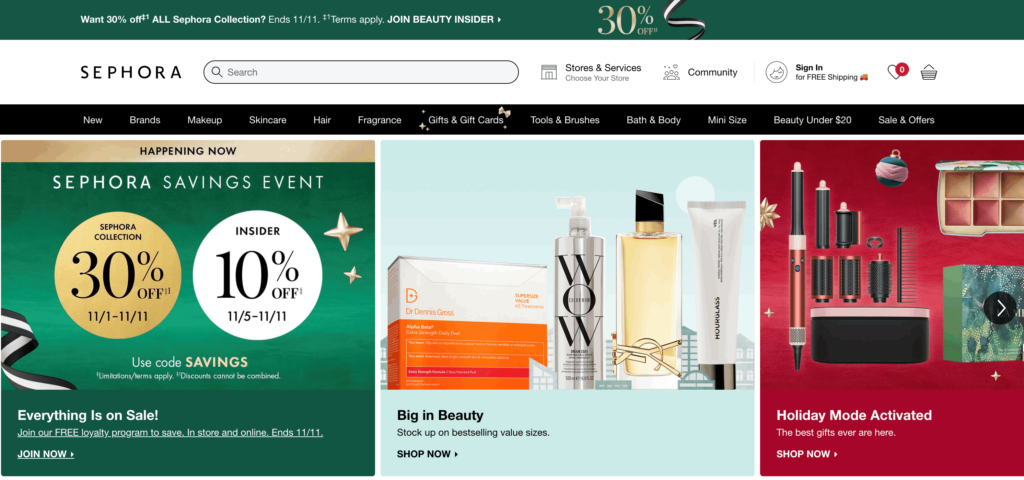
For example, with every order, Sephora includes a choice of skincare, fragrance, or makeup samples. This indirect approach increases exposure to a wider range of products while providing a low-cost way for the brand to upsell other items in their catalog.
A direct product sampling strategy is just the opposite. You make a connection with your consumers and keep that relationship. i.e. offering free samples by sending them to their homes.
Lush Cosmetics is known for providing free samples of their skincare and bath products directly to customers in-store. Staff members engage with visitors, explain the benefits of products, and offer samples tailored to customers’ skin type or needs.
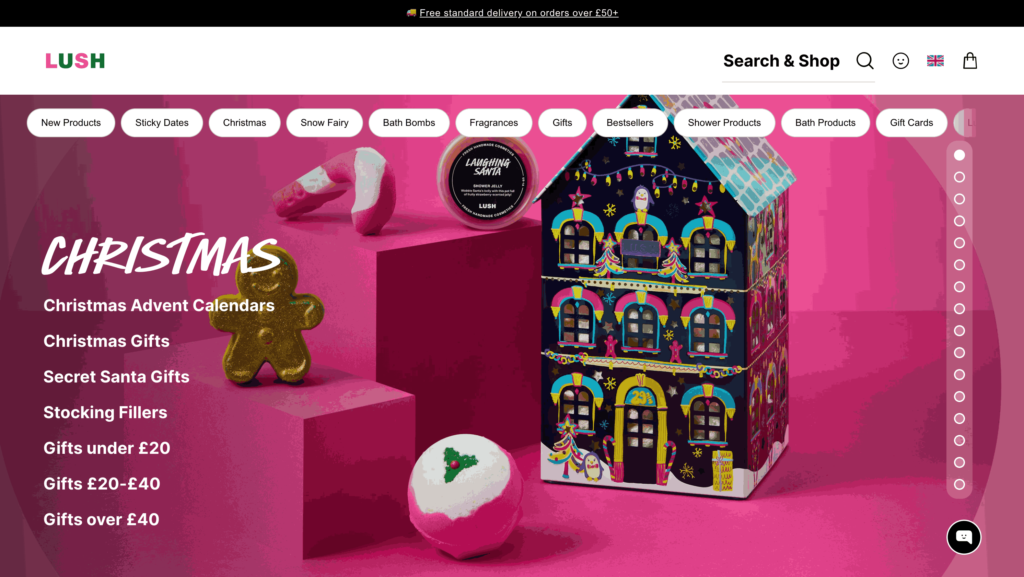
This face-to-face interaction allows Lush to build a personal connection with consumers and encourage them to make a purchase, fostering brand loyalty.
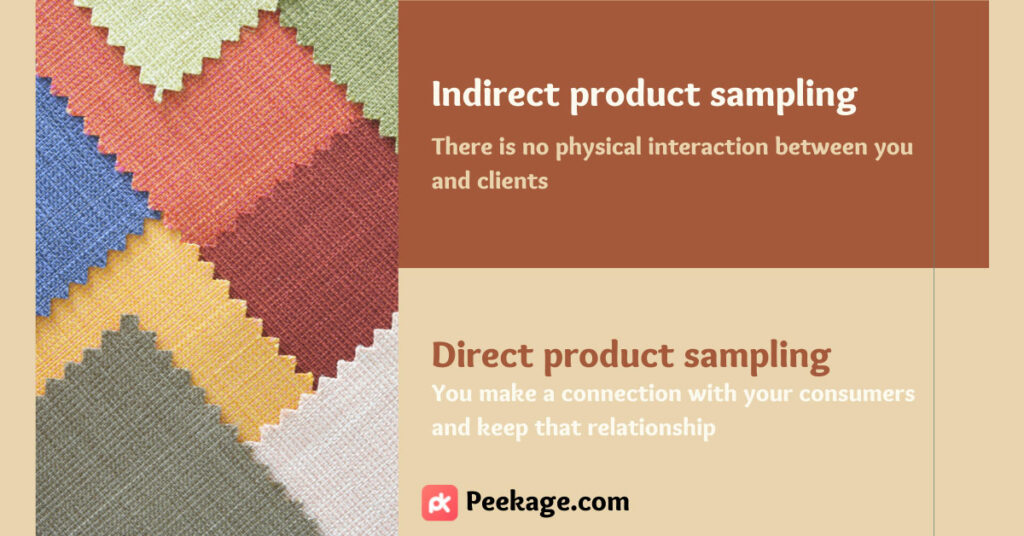
If you are skeptical about the working mechanism of product sampling and want to know more about it, you are in the right place.
The Psychology of product sampling
There are three important psychological constructs that can explain why product sampling is an effective product marketing strategy for your business:
- First is the concept of risk aversion.
Keep in mind that we often make irrational decisions because if our brain tries to go in-depth about every decision we make, it will use up all our energy. To be energy efficient, we make decisions on a whim.
Most of the time, we pick familiar products instead of unfamiliar ones that are probably more sustainable, environmentally friendly, and better for our lifestyle.
That makes sense because why would you spend your money on something you can not possibly be sure about? Therefore, product sampling minimizes the risks for consumers because they are not paying for anything while being able to try the product.
- The second concept of psychology is reciprocity.
Recent social psychology studies have shown that waiters who give free candies to customers are found to get more tips than waiters who don't give anything at all.
Notice that these customer service workers don't actively ask for anything in return and are still rewarded for it.
This is how reciprocity can also apply to product sampling. The free products that you let consumers try may even get them to buy your product in the future.
- Lastly, once you've subconsciously made a good impression on consumers, they would have a relatively good sentiment about you and your products.
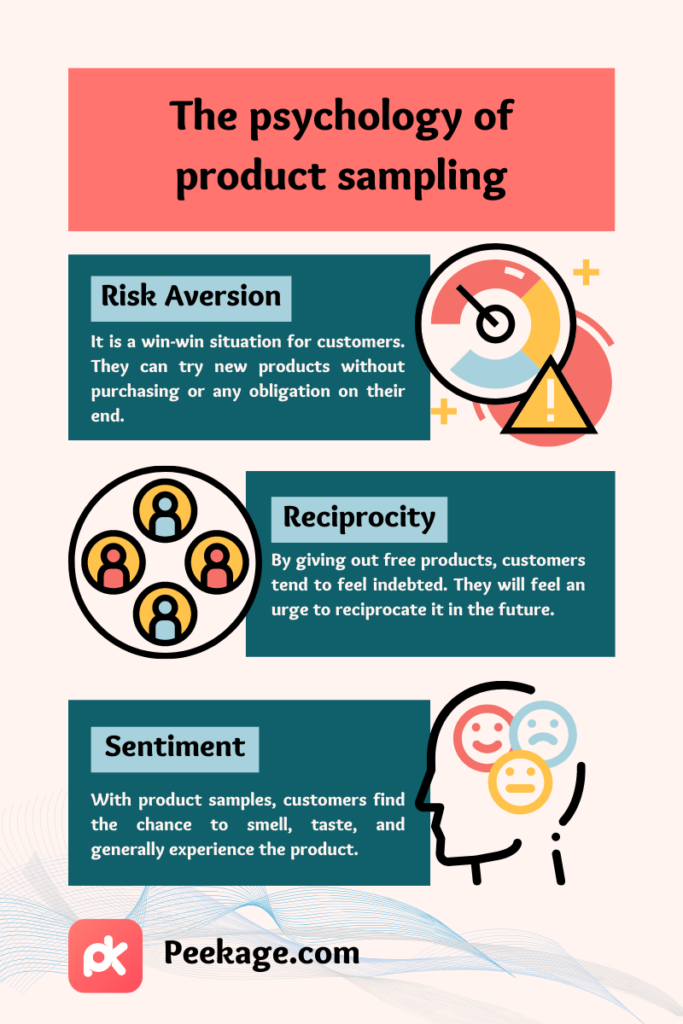
Read more: The Psychology Behind Consumer Sampling Programs
You have just increased the chance of them buying from you in the future.
In short, by using the product sampling method, you are hacking your way into your consumers' brains and subconscious.
What are product sampling methods?
Product sampling strategies are essential for brands wanting to introduce their offerings in a way that creates strong consumer engagement and drives conversions.
Sampling products, especially in luxury markets, requires thoughtful planning to ensure brand integrity and high ROI. Below, we explore different sampling methods, each tailored to specific goals and audiences, along with a real-world example of a luxury brand that leveraged sampling marketing strategy successfully.
1. In-Store Sampling
In-store sampling is a direct product sampling strategy where brands allow consumers to experience a product firsthand within a retail environment. This strategy works well for premium products because it engages consumers at the point of purchase, where they’re already in a buying mindset.
Real world Example: Dior often uses in-store product sampling marketing at high-end department stores like Nordstrom and Saks Fifth Avenue.

Through in-store fragrance samples, Dior allows consumers to try luxury perfumes, such as Dior Sauvage, which saw a 32% sales increase after the sampling campaign.
This in-store approach taps into the psychology of sampling by reducing risk for consumers and allowing them to experience the scent firsthand.
2. Direct-to-Consumer Sampling
A direct-to-consumer (DTC) sampling strategy involves sending product samples directly to potential customers' homes.
This approach creates a personal touch and gives luxury brands the opportunity to connect with an exclusive audience without the need for retail locations.
Real world Example: La Mer, a luxury skincare brand, implemented a DTC sampling marketing campaign where select customers received product samples, including the brand's iconic Crème de la Mer moisturizer.

By targeting a high-income demographic through exclusive sampling products, La Mer generated a conversion rate of over 45% among recipients, proving that a well-executed product sampling strategy can turn trial into loyalty.
3. Event-Based Sampling
Event-based sampling involves distributing samples during special events, such as fashion shows, luxury car launches, or exclusive galas.
For luxury brands, event-based sampling is an excellent way to engage a high-value audience, as attendees are often aligned with the brand's target market.
Real world Example: Moet & Chandon used event-based product sampling marketing at luxury gatherings like the Cannes Film Festival.
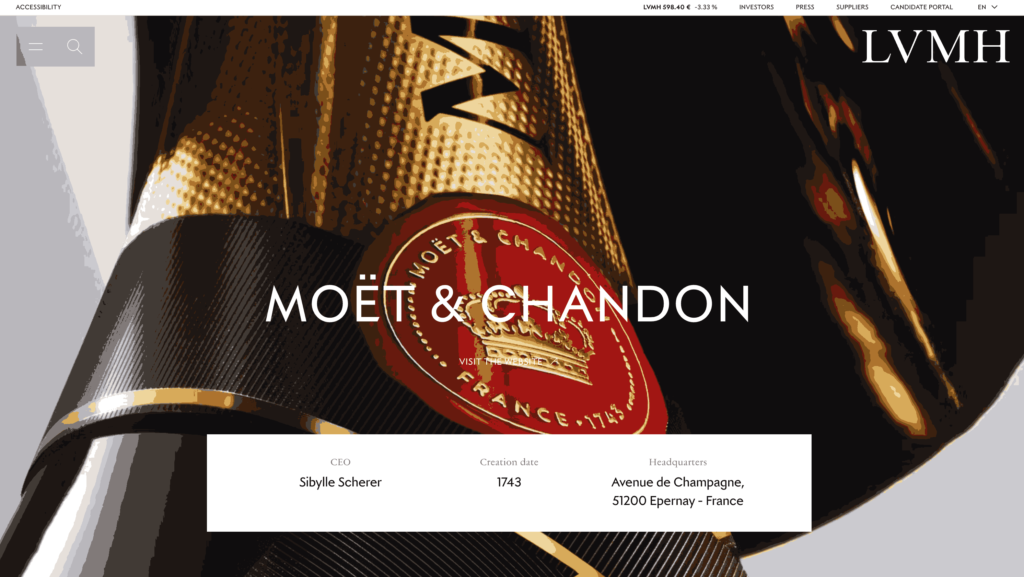
By providing product samples of its high-end champagne to VIP guests, Moet & Chandon increased brand exposure and generated significant media coverage. Event sampling like this not only aligns with the brand's upscale image but also creates memorable experiences that reinforce brand loyalty.
4. Subscription Box and Trial Kit Sampling
Subscription box sampling is a modern sampling strategy where brands partner with curated subscription services or create their own trial kits.
This product sampling marketing method reaches an audience interested in trying new products and encourages them to explore premium offerings at a lower cost.
Real world Example: Chanel partnered with subscription box service Glossybox to include mini samples of its luxury fragrances and skincare items.
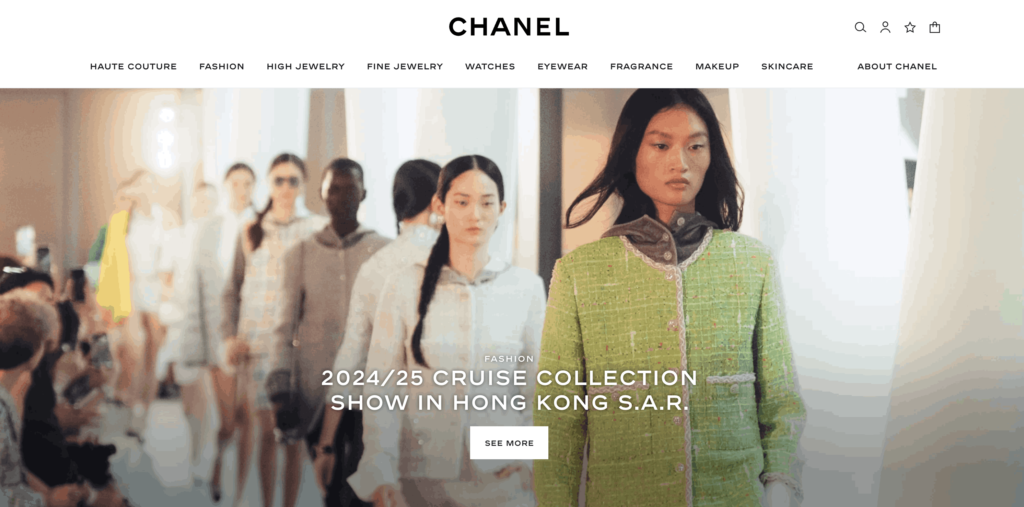
By targeting over 50,000 Glossybox subscribers, Chanel effectively used product sampling to reach a highly engaged audience, leading to a 20% uplift in full-size purchases after the campaign.
This method allows luxury brands to generate interest in sampling products without compromising exclusivity.
5. Digital product sampling
Digital product sampling leverages online channels to distribute samples, often using vouchers or QR codes that consumers can redeem in-store.
For luxury brands, digital sampling can be an effective way to bridge the online and offline experience, introducing potential customers to a high-end product in a way that maintains brand prestige.
Real world Example: Gucci used a digital product sampling strategy for its fragrance line, offering digital vouchers through social media ads that could be redeemed at Gucci boutiques.

This sampling marketing strategy resulted in a 40% redemption rate, with many recipients making additional purchases in-store.
Gucci's approach showcases how luxury brands can adapt digital sampling to provide exclusive experiences while expanding their reach to a broader, yet still targeted, audience.
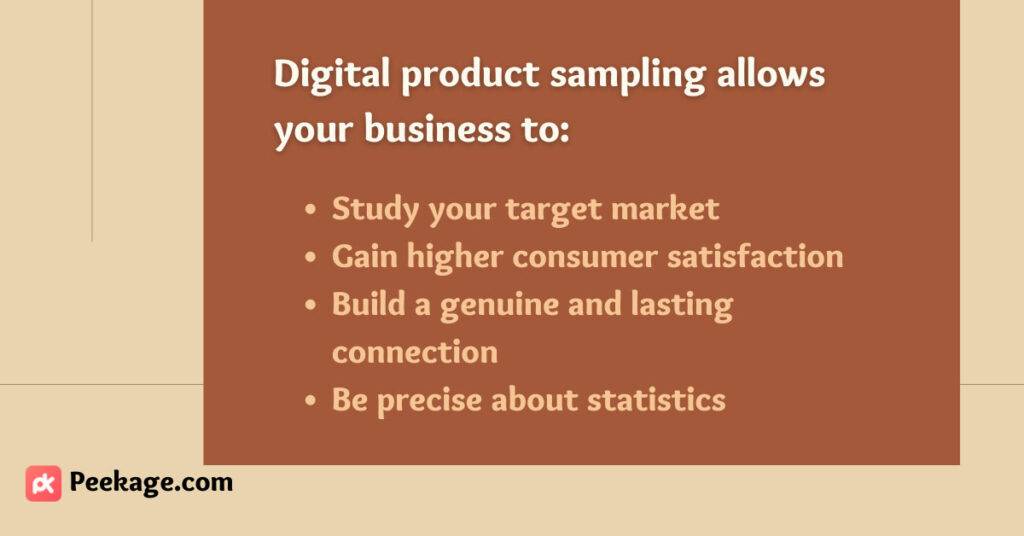
Read more: Digital Product Sampling vs. Traditional Product Sampling
We highly recommend that you opt for the second option and take the digital product sampling route. It may be a longer one, but you will get where you want to be, satisfied.
Comparing Product Sampling Strategies: Pros and Cons of Each Approach
| Method | Pros | Cons |
| In-Store Sampling | High engagement: Allows direct, personalized interaction with customers. Immediate feedback: Sales associates can gather insights instantly. High conversion: Seeing, testing, and discussing the product increases impulse buying and conversions, sometimes up to 25% in some cases. | High cost: Requires physical locations and staffing, which can be costly. Limited reach: Only engages customers who are already in-store. Time-consuming: Requires staff training to ensure brand standards are met. |
| Direct-to-Consumer (DTC) | Personalized experience: Luxury brands can create a high-touch, exclusive feel. Reach: Can be targeted to specific demographics or regions. Retention: High potential for customer loyalty and long-term retention (can increase retention by around 20%). | Logistical complexity: Shipping and handling are complex, especially internationally. Expensive: Packaging and shipping samples can be costly. Limited interaction: No immediate feedback on customer reactions unless follow-up mechanisms are in place. |
| Event-Based Sampling | Brand exclusivity: Luxury events create memorable, high-status brand experiences. High visibility: Events often generate social media buzz, especially among influencers. High recall: Consumers remember the product and experience, enhancing brand association. | High cost: Events require significant planning and budget (venue, staff, etc.). Limited frequency: Events are often one-off or occasional, limiting continuous engagement. High setup: Requires careful planning to ensure luxury standards. |
| Subscription Box/Trial Kits | Large reach: Access to a broad demographic through popular subscription services. Cost-effective: Brands often share distribution costs with the subscription service. Conversion: Approximately 30% of trial users may convert to full-size purchases. | Brand dilution risk: Shared boxes may make luxury brands seem less exclusive. Limited targeting: May not always reach the most affluent target audience. Limited control: Brands have less control over presentation and experience quality in third-party boxes. |
| Digital Product Sampling | Broad reach: Reaches both digital-savvy consumers and younger demographics. Convenient: Seamlessly integrates with e-commerce and digital campaigns. Data collection: Easy to collect data on customer interactions and conversions. | Low engagement: Lacks the hands-on experience of physical samples. Lower conversion: Digital samples (vouchers, discounts) can sometimes have a lower conversion rate than physical samples. Requires strong digital infrastructure and customer support for redemption. |
What does an effective product sampling look like?
Now let's talk about the details of an effective product sampling campaign:
1. Know your goals and objectives clearly.
Identify what you want to get out of this campaign; riddle yourself these questions:
- What do you hope to achieve by product sampling?
- Why do you want to send these specific sample products?
- Do you want coverage before your launch?
2. Know / Pick your target Audience
Make sure that the individuals you are targeting are the ideal audience.
If you know what group of people you want to target, get to know them on a deeper level, and if you want to find the right target market for your product, study the market and your competitors' consumer base.
3 . Time your sampling campaign right
Start campaigning products a few weeks or even a few months before launching them.
This will help generate reviews and will give consumers a chance to familiarize themselves with your product. In addition, pick the right time for your product launch.
For example, try launching your school supply product a few weeks before the new semester starts.
4. Follow post-purchase updates after customers receive their samples
You can send post-purchase emails; send out questionnaires. However, there are applications and companies that can manage the whole process of product sampling for you and even handle post-purchase updates, which is a challenging and dubious task.
5. Review and repeat
Product sampling is not just about first impressions. It's about making a lasting impression.
Keep your ear to the ground and read reviews. Reply as much as you can and resolve consumer concerns to the best of your ability.
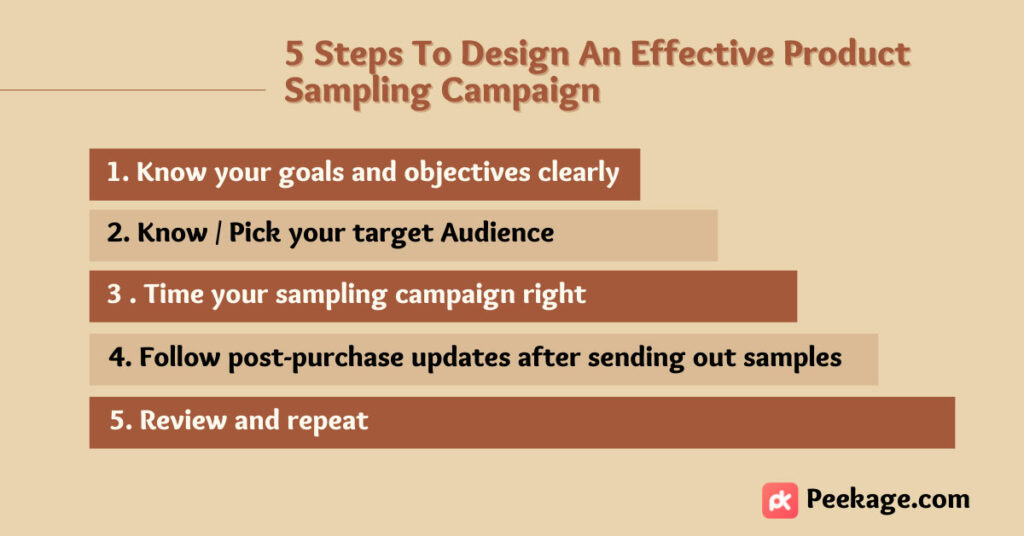
Product sampling is a process, meaning there is no finish line. You can always tweak and repeat this procedure to maintain the product-market-fit status.
Read more: E-Commerce & Digital Product Sampling - A Perfect Marriage
How to plan and manage a successful product sampling campaign?
Let's break this into two parts: Planning and managing.
Planning a product sampling campaign
If you are going to plan a product sampling campaign and want it to succeed, you have to answer the following questions honestly:
- Why do you want to launch this campaign? (And please don't say because a competitor did it!)
- What is the product you want to distribute, and how many? (You have to plan your campaign around your new product, not the other way around)
- Who do you want to send your samples to? (Be very specific. Answers like "women", "young people", or "pet owners" are too vague and broad)
- How do you want to deliver your samples? (Online, in person, in-store, etc.)
- What will be your method of interaction with your potential buyers? (Email, Phone, questionnaire, etc. Again, be very specific.)
- When do you want to launch your new product? (If you think you can do it anytime, then think again)
- How much time do you have? (If you don't have a deadline, then you need one)
- How much time do your potential consumers have to review your sample? (It has to be a perfect balance of time, so you would not rush them, but it also has to be fast enough so they can give their feedback with a fresh memory)
- How much money are you willing to spend? (Remember that going about a product sampling campaign alone can be costly)
Answering these questions specifically helps you to plan your product sampling marketing road map.
Yet, we know that finding the exact answer to some of these questions may be challenging, and that is why Peekage offers a free consultation session to its customers before starting any product sampling procedure.
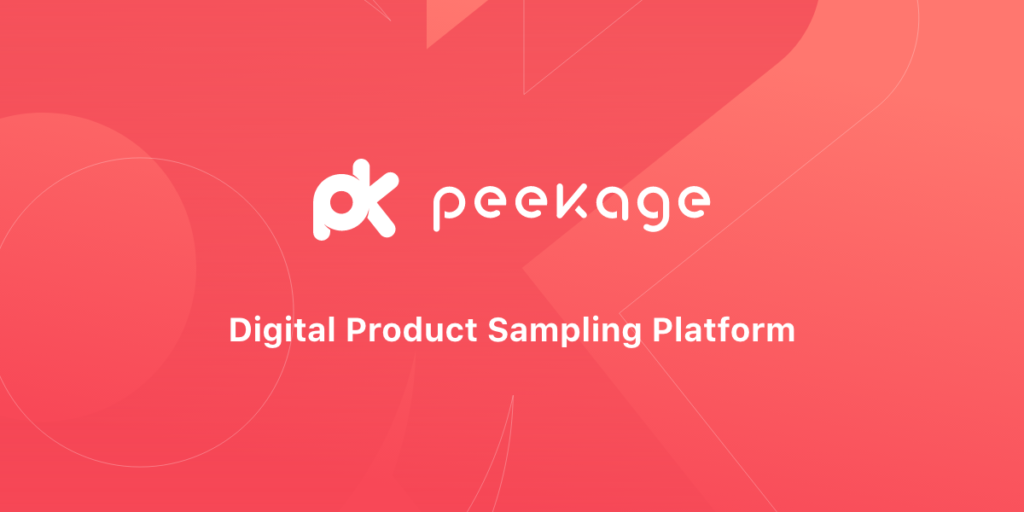
Managing a product sampling campaign
If you are going to manage a product sampling campaign and want it to succeed, you have to be extremely detail-oriented and great at follow-ups. Here are some obstacles you may encounter while managing a product sampling campaign:
Fuzzy goals for the campaign
sometimes, each team member has a different goal in mind for a campaign, sometimes you may set goals that are not in alignment with your overall growth strategy, and other times you may set goals that are not measurable or attainable.
Choosing the wrong audience or failing to recognize them
You may have difficulties knowing who will be a good match for your product and where they live. Basically, you need access to a live and updated database.
The overwhelming number of tasks regarding the product
You have to know how many samples you will need, how much they will cost, where you want to store them, and how you want to deliver them. Being on top of all product-related tasks is a handful.
Expenditure
Managing finances in a product sampling is more than just estimating a number it will cost. You have to adhere to your spending plan every step of the way.
Deliveries
Depending on your delivery method, you need to consider packaging, storing, and shipment, which all may alter the final cost estimation and screw up your timetable.
Consumer support
Again, depending on your chosen method, you have to be prepared to answer your customers about any number of things, including delivery mix-ups, faulty packages, complaints, comments, etc.
Data gathering method
You must have a unified method of data gathering within your company. All your product sampling team members have to have the same accuracy in data collection and recording.
Data analysis
After gathering user feedback, you need to analyze it into useful information that is meaningful for your product owner and design team.
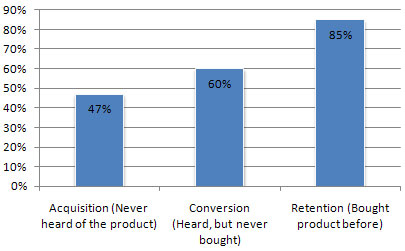
Why Consumer Feedback is Essential for Product Sampling?
Consumer feedback is the backbone of effective product sampling strategies. When brands allow consumers to try a product sample, it opens an avenue for gathering valuable insights into preferences, pain points, and product reception.
Feedback helps brands fine-tune their offerings, ensuring that product improvements are aligned with consumer expectations. For brands wondering how to do product sampling effectively, including structured feedback mechanisms like surveys or review requests is crucial.
Positive feedback not only validates the sampling strategy but also acts as a promotional asset for sampling marketing efforts.
Maximizing Reach with Influencer and Partnership Campaigns
Leveraging influencers and partnerships in product sampling marketing can amplify reach and engagement, especially for luxury or lifestyle brands. Influencers help introduce products to a broad, engaged audience, while partnerships with complementary brands expand market visibility.
These sampling marketing strategies bring the product directly to the target audience in an authentic way.
For instance, collaborations with beauty influencers for skincare samples drive substantial engagement and create social proof. This sampling strategy makes it easier for consumers to trust and try a product they see endorsed by trusted personalities.

Sustainable Product Sampling Practices: A Growing Trend
Sustainability is increasingly significant in product sampling strategies as consumers prioritize eco-friendly brands. Sustainable sampling practices involve using recyclable or biodegradable packaging and reducing waste by offering smaller, more efficient sample sizes.
Brands can also reduce the environmental impact by providing digital sampling vouchers instead of physical samples, allowing consumers to redeem samples at specific locations.
This growing trend meets the dual demands of responsible sampling marketing and environmentally conscious consumers, aligning with sampling marketing strategy while bolstering brand reputation.
Harnessing User-Generated Content for Product Sampling Success
User-generated content (UGC) is a powerful tool for product sampling marketing, especially in today's digital-first environment. When consumers post about their experiences with a product sample, it generates organic buzz and creates social proof.
Brands can encourage UGC by creating branded hashtags or offering incentives for sharing feedback.
Product sampling strategies that include UGC not only increase reach but also add authenticity, as potential customers see real people using and enjoying the product. This sampling strategy builds community, loyalty, and visibility simultaneously.
Integrating Digital and Physical Sampling Experiences
The integration of digital and physical sampling enhances consumer engagement by offering a seamless omnichannel experience. For instance, brands can provide QR codes with product samples that link to online tutorials, product benefits, or exclusive discounts.
This approach connects digital engagement with a tangible product experience, maximizing the effectiveness of sampling products.
For brands exploring what is product sampling in today's market, combining digital touch points with physical samples is a way to provide a comprehensive experience that encourages conversions.
Budget-Friendly Product Sampling Strategies for Emerging Brands
Emerging brands can still engage in effective product sampling strategies without a large budget by focusing on low-cost yet impactful methods.
Tactics such as partnering with micro-influencers, offering sample sizes through e-commerce orders, or distributing samples at local events can help maximize reach.
For cost-effective sampling products, small brands may also consider digital sampling, such as offering digital vouchers redeemable for product samples in-store.
These budget-friendly options allow emerging brands to introduce their products to new audiences without the high costs associated with large-scale sampling campaigns.
Navigating Challenges in Product Sampling: Common Issues and Solutions
Product sampling strategies often come with challenges, such as logistical difficulties, managing consumer expectations, and ensuring product quality in distribution.
One common issue is tracking the effectiveness of each product sampling method. Brands can overcome this by setting clear objectives, using data analytics, and adjusting strategies based on consumer feedback.
Another challenge is ensuring the sampling marketing approach aligns with brand identity and customer experience. By addressing these obstacles, brands can create smoother and more successful sampling campaigns.
Communication
The product sampling procedure requires constant communication between the marketing and design teams. It is not a one-way street, and both parts affect each other. Sometimes it might be hard to keep the balance between these parts.
We know that managing a product sampling campaign can be a stressful and daunting task. This is why most companies (From small businesses to big corporations) chose to outsource this process to capable third parties.
Read more: Maximize the Success of Your Product Sampling Campaign
Peekage is a platform that enables you to plan, run and manage your product sampling campaign hassle-free.
Key takeaways
- Sampling enhances brand reputation by establishing consumer trust through firsthand experience.
- Satisfied customers often share their experience, acting as brand advocates.
- Digital sampling delivers targeted feedback to guide product and marketing strategies.
- Eco-friendly and digital sampling reduces waste and appeals to eco-conscious consumers.
- Collaborations with influencers and brands broaden sampling campaign reach.
- Hybrid sampling strategies maximize engagement across online and offline channels.
